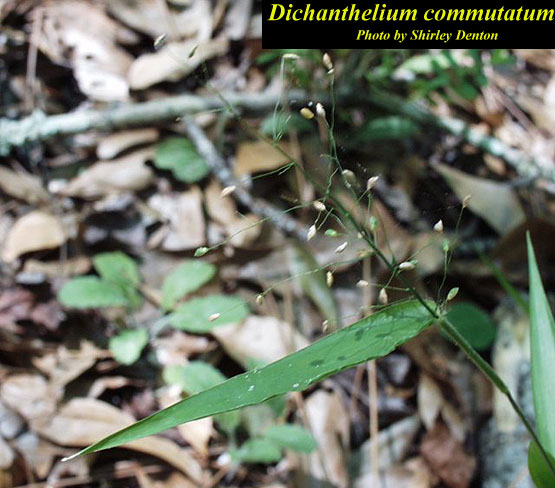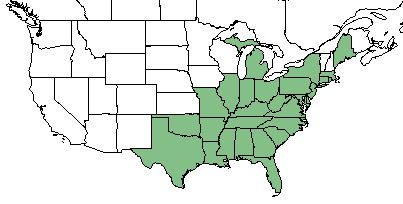Difference between revisions of "Dichanthelium commutatum"
(→Distribution) |
(→Ecology) |
||
| Line 30: | Line 30: | ||
==Ecology== | ==Ecology== | ||
| − | ===Habitat=== <!--Natural communities, human disturbed habitats, topography, hydrology, soils, light, fire regime requirements for removal of competition, etc.--> | + | ===Habitat=== |
| − | + | Common habitats for ''D. commutatum'' include low, shaded, moist woodlands and edges of woodlands, as well as dry, thin, and rocky woods and thickets. <ref name= "Weakley"> Weakley, A. S. (2015). Flora of the Southern and Mid-Atlantic States. Chapel Hill, NC, University of North Carolina Herbarium.</ref> | |
| + | |||
| + | ''D. commutatum'' has a medium tolerance for drought and shade. <ref name= "USDA"> [https://plants.usda.gov/core/profile?symbol=CEAM USDA Plant Database]</ref> | ||
| + | <!--Natural communities, human disturbed habitats, topography, hydrology, soils, light, fire regime requirements for removal of competition, etc.--> | ||
| + | ===Phenology=== | ||
| + | ''D. commutatum'' will typically bloom during spring, with April producing the majority of blooms. <ref name= "Pan Flora"> [http://www.gilnelson.com/PanFlora/ Pan Flora]</ref> | ||
| + | <!--Timing off flowering, fruiting, seed dispersal, and environmental triggers. Cite PanFlora website if appropriate: http://www.gilnelson.com/PanFlora/ --> | ||
<!--===Seed dispersal===--> | <!--===Seed dispersal===--> | ||
<!--===Seed bank and germination===--> | <!--===Seed bank and germination===--> | ||
| − | + | ===Fire ecology=== | |
| + | ''D. commutatum'' has no tolerance for fire. <ref name= "USDA"> [https://plants.usda.gov/core/profile?symbol=CEAM USDA Plant Database]</ref> | ||
| + | <!--Fire tolerance, fire dependence, adaptive fire responses--> | ||
<!--===Pollination===--> | <!--===Pollination===--> | ||
<!--===Use by animals===--> <!--Herbivory, granivory, insect hosting, etc.--> | <!--===Use by animals===--> <!--Herbivory, granivory, insect hosting, etc.--> | ||
Revision as of 08:57, 30 May 2018
| Dichanthelium commutatum | |
|---|---|

| |
| Photo by the Atlas of Florida Plants Database | |
| Scientific classification | |
| Kingdom: | Plantae |
| Division: | Magnoliophyta - Flowering plants |
| Class: | Liliopsida - Moncots |
| Order: | Cyperales |
| Family: | Poaceae |
| Genus: | Dichanthelium |
| Species: | D. communtatum |
| Binomial name | |
| Dichanthelium commutatum Schult. | |

| |
| Natural range of Dichanthelium commutatum from USDA NRCS Plants Database. | |
Contents
Taxonomic Notes
Synonym: none
Variety: D. commutatum var. ashei (J.A. Shultes) Gould
Description
D. communtatum is a perennial gramioid of the Poaceae family that is native to North America. [1]
Distribution
D. commutatum is found throughout the eastern United States, reaching as far west as Texas and as far north as Maine and Michigan. [1]
Ecology
Habitat
Common habitats for D. commutatum include low, shaded, moist woodlands and edges of woodlands, as well as dry, thin, and rocky woods and thickets. [2]
D. commutatum has a medium tolerance for drought and shade. [1]
Phenology
D. commutatum will typically bloom during spring, with April producing the majority of blooms. [3]
Fire ecology
D. commutatum has no tolerance for fire. [1]